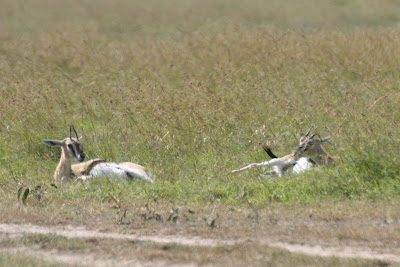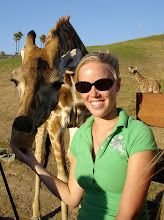Those of you who have been following this blog know that a few weeks ago the African Journal of Ecology published a short note of mine on an interesting aggressive interaction between a warthog and a newborn Thomson's gazelle. For those unfamiliar, the official version is available
here and the blog account of the event is available
here.
It was a very shocking interaction and in doing my research for the note, I found no other mention in the literature of warthogs predating or behaving aggressively toward Thomson's gazelles. As I indicate in the note, it seemed like an aberrant, unusual occurrence.
Well.
A couple weeks ago I was watching a tommy mother who was in a group with a male tommy and one other female. The other female had swollen udders (usually a sign of motherhood) but was also quite fat, so I figured she was probably pregnant. I decided to do an observation on her simultaneously with the observation of the mother in order to compare their behavior. Only she didn't stay pregnant for long!
About an hour into the two hour observation, she started holding her tail out and to the side in a very peculiar position. I knew what was about to happen and started up my video camera to record the events (video to be posted when it won't cost me a fortune in internet fees). Soon she reclined again and contractions began, causing her to lift all four legs off the ground as she strained:
Then she stood up mid-delivery:
And settled back down to finish in a more comfortable position:
And soon enough, a calf!
The mother was distracted a few times by the male tommy who took her tail position as an invitation to mate and by some Grant's gazelles that were in the group and took an interest in figuring out what the new addition was. The mother also appeared to be somewhat afraid of her new baby, trying to evade it as it staggered towards her. Eventually though she committed to cleaning it off and letting it nurse.
Those of you who would prefer to believe that nature is all Bambi and Thumper and that Pumbaa would be best friends with a bite-sized meerkat should just accept this alternate and entirely false ending: the mom and baby lived happily ever after.
What really happened though was not a happy ending, but ANOTHER warthog attack! I saw the warthog in the distance while the mom was busy figuring out how to mother and kept an eye on it on the off chance that I should witness another fluke attack. Well, it seems attacks might not be so flukey.
The warthog came to investigate the situation, possibly because of the activity caused by the interfering Grant's gazelles. The mother was easily frightened off by the warthog, which outweighed her by a factor of three at least. The warthog glanced at the baby that was lying in the grass briefly and then appeared to begin to move on. However, before mom could return, the baby got up and, programmed by instincts, staggered towards the closest large thing, which happened to be the warthog. The warthog was confused for a moment and flicked the calf with its snout, knocking it to the ground. Then it investigated closer. First it just nibbled at the remaining birthing materials on the calf's coat, but soon it went all in and started eating the baby.
Now, warthogs are not well-equipped for killing and eating meat, having no carnassial teeth. It was not a particularly quick or merciful death for this poor little guy. The warthog's main tactic seemed to be to hold the calf down with its front legs and then pull the calf up with its head, essentially gumming and tearing it to death. Here is a somewhat grisly picture of a now very dead and mostly flayed gazelle:
After twenty or so minutes of ineffecient consumption of its kill, the warthog lost interest and left. About a half hour later, a jackal came and made off with the rest:
Poor mama kept checking back at the birth site over the next hour, obviously feeling that there was something important she was supposed to do at that site, but never finding the baby. Nature is sometimes cruel.
Several days later, I observed my third tommy birth. I will spare most of the specifics, but this mother was also distracted from her postnatal duties (this time by a pair of cattle herders walking down the nearby road) and this was the result:
But a few days after that I finally saw a birth where the mother was undisturbed and the calf lived longer than 45 minutes! Here is the proud mama and calf:
Aww!
(About an hour after the mother hid the calf in vegetation for the first time, the calf emerged only to be immediately head-butted and knocked over by a subadult warthog. The calf was steady enough on its feet to recover and run away and so survived, but something is seriously up with the warthogs at Ol Pej).











